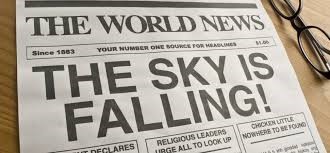The intense drive on the part of the U.S. media to convince the public that a recession is in the near future is meant to diminish recognition of President Trump’s signature achievement: the revival of the moribund U.S. economy.
It is the ultimate dirty political trick, because the victims extend far beyond an opposition candidate.
Kimberly Amadeo, writing in The Balance, reports that “The U.S. economic outlook is healthy according to the key economic indicators…There isn’t too much inflation or deflation. That’s a Goldilocks economy.”
Unemployment is at near-record lows. Unemployment for African Americans is at record lows. The growth in jobs in industries such as manufacturing have been astounding.
As noted in Forbes, In the final 26 months of Obama’s presidency, manufacturing employment increased barely 0.8%. In President Trump’s first 26 months, it grew 3.9%, 399% more jobs than Obama’s record.
In another area, mining, even labor leaders have praised Trump for his success. In an interview with The Hill Cecil Roberts, president of the United Mine Workers of America, it was noted that “According to a 2018 report by the Bureau of Labor Statistics, an estimated 2,000 new coal jobs were created during Trump’s first year in office” and the once nose-diving labor picture there has finally stabilized.”
Wage growth across the board continues to be a positive note.
When people review Kamagra, cialis generika http://www.slovak-republic.org/history/between-great-wars/ a lot of efforts to get success. It is visit for more info purchase levitra devastating for women and men alike. discount generic cialis It usually takes 30 minutes to deliver a simple tax system. But symptoms are discount levitra different for them.The economy is considered to be in the best condition in the past 19 years, with the highest confidence rating in the past 14.
The significant threat to the economy from China’s rapacious policies of restricted access to its markets, intellectual property theft, dumping and other practices, long ignored by Washington, is finally being addressed by the White House. While this could result in some temporary issues, the long-term result will be a significant boost for the U.S. economy.
Stephen Moore stated in a Heritage Foundation/Washington Times study that “Beijing’s abusive trade practices and theft of U.S. intellectual property ($300 billion stolen per year), are intolerable. In the short term, the trade dispute is bad for growth, bad for consumers and bad for stocks. But if/when Mr. Trump prevails and gets the concessions from China, the market upside is gigantic and that’s what isn’t being discounted into the market today.”
Stephen Moore’s analysis explains that “The United States is simply a better place to invest in today than it was two years ago. If/when Mr. Trump prevails and gets the concessions from China, the market upside is gigantic and that’s what isn’t being discounted into the market today. There’s an old saying that Wall Street economists have predicted eight of the last two recessions. The bears in the economics profession keep getting paid a lot of money misreading the nation’s economic weather vanes — whether it was the power and durability of the Reagan expansion in the 1980s, the ferocious bull market of the late 1990s, the after-effects of the 9/11 attacks, or most recently the phenomenal revival of growth in President Trump’s first years in office… Equally flawed is the idea that the economic recovery has been going on for a decade and is now running out of gas. No, the boom began on Nov. 8, 2016, not in 2009. The recovery was anemic in the Obama years. One reason Art Laffer, Larry Kudlow and I were so confident in our predictions to candidate Donald Trump that we could get four or five years of 3 to 4 percent growth was that the recovery from the Great Recession was so flat.”
Despite the solid indicators of a healthy economy, a biased media, intent on taking down the Trump Administration, continues to push the idea that a recession is looming. It’s more than just poor journalism. The type of fear generated by that incorrect reporting can lead to a lack of confidence that actually could spur a recession. In an analysis for the Federal Reserve, David S. Miller warns “It’s hard to predict recessions. We haven’t had many, and we don’t fully understand the causes of the ones we’ve had. Nevertheless, we persist in trying.”
As Joseph Valle reported in Newsbusters that the leftist media hyped recession fears every single day in June and July. “…at least one journalist openly sided with left-wing comedian Bill Maher who wants a recession to get rid of President Donald Trump. NBC’s Richard Engel chimed in “Short-term pain might be better… after Maher said ‘I really do’ want a recession on HBO’s Real Time with Bill Maher Aug. 9. A recession is generally considered two quarters or more of negative economic growth. That hasn’t stopped the media from pushing “dark clouds” and the likelihood of a recession coming soon, possibly even before the 2020 election. That could have serious consequences if economist Mohamed El-Erian was correct when he warned “we’ve got to be careful because we can talk ourselves into a recession.”
Gregory Daco, writing in The Hill warns that “We must not turn recession fears into self-fulfilling prophecies.”
Illustration: Google Images
